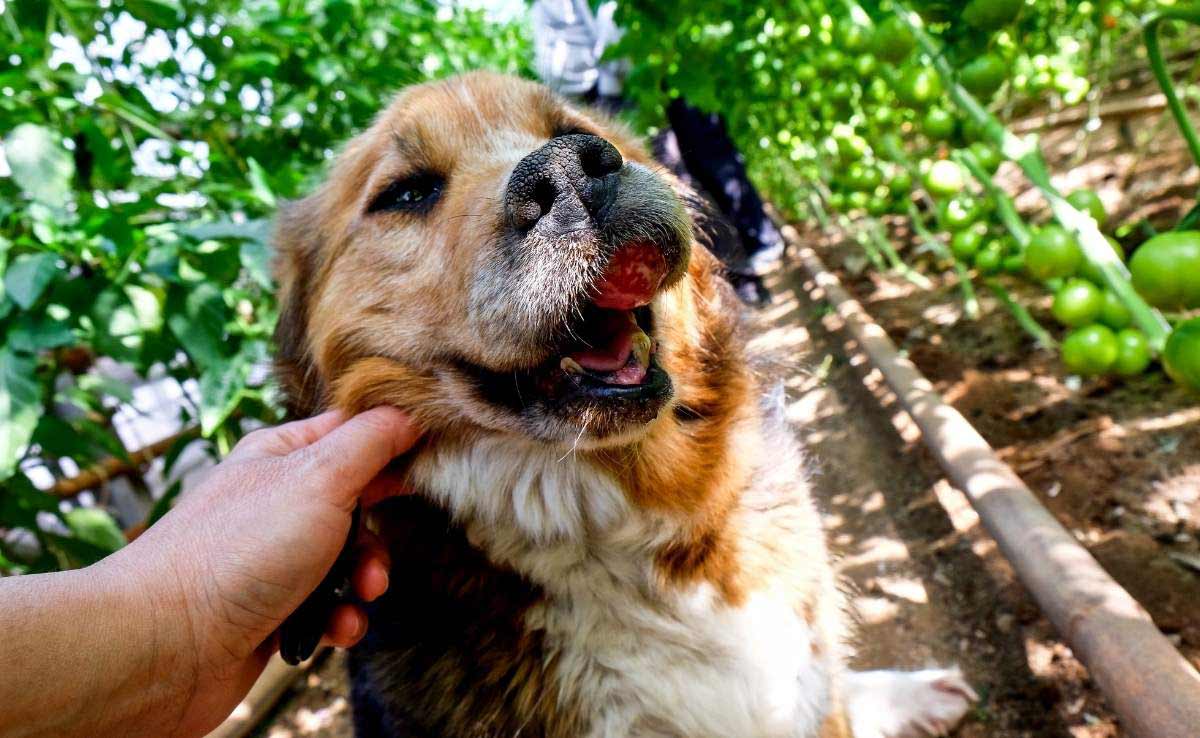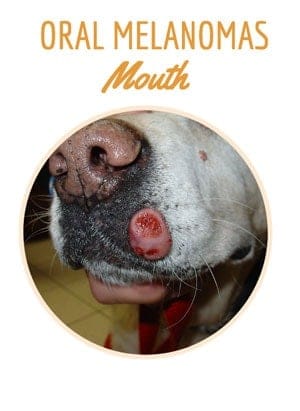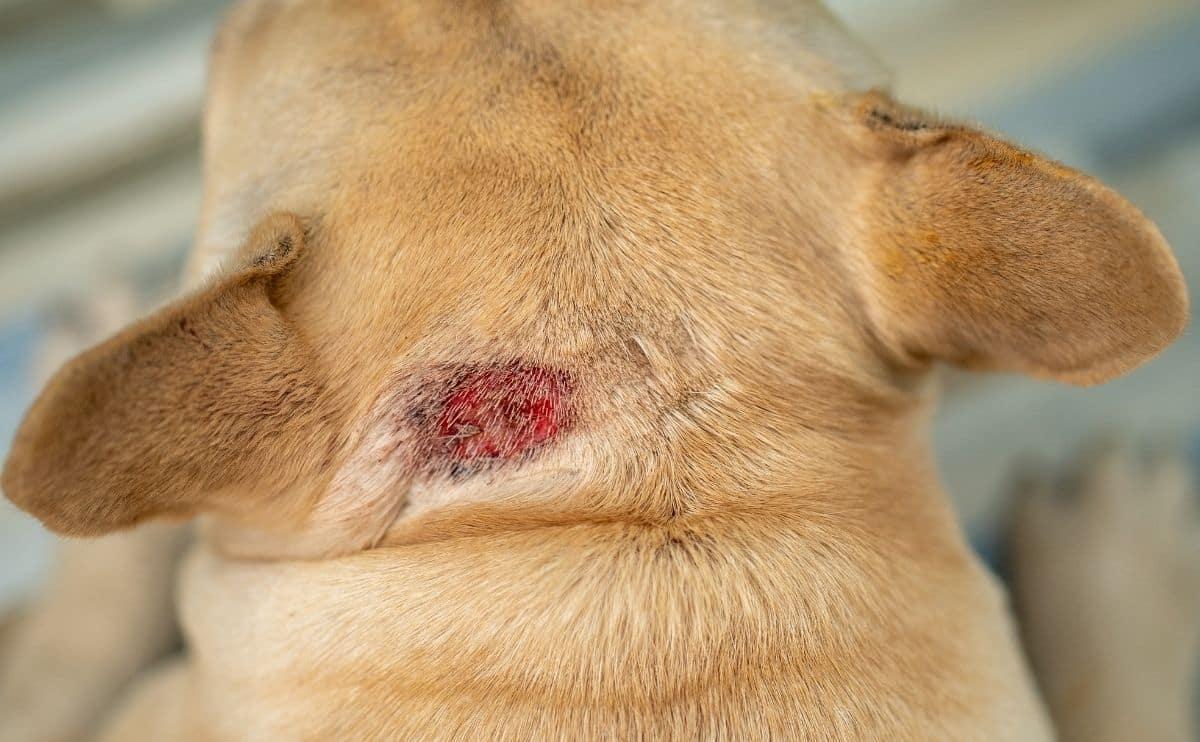Mouth Cancer In Dogs: Symptoms, Diagnosis & Treatment Options
When you purchase through links on our site, we may earn a commission. Here’s how it works.
Just like people, dogs can develop growths in their mouths. These are called oral tumors, accounting for 6-7% of all dog cancers. Oral cancer in dogs is usually primary, meaning it arises directly from the mouth’s tissues. Some are benign but can be pesky, whereas some are malignant and need to be tackled quickly and aggressively.
Table of Contents

What Are The Symptoms Of Mouth Cancer In Dogs?
The symptoms of oral cancer in dogs are usually directly related to where the tumor is growing and how big it is. For instance, dog lip cancer might be easy to spot, but dog gum cancer, or a growth deeper inside the mouth, can be harder to spot until it causes problems, such as impairing chewing or swallowing.
Therefore, many dogs with oral cancer have no symptoms for a while, and the tumor is picked up accidentally by the owner or the vet. In other cases, there can be symptoms, such as new or excessive drooling, bad breath, bleeding from the mouth (or occasionally the nose), swelling or deformity of the face, and difficulty eating, chewing, or fetching.
Before we get into the nitty-gritty of the different types of mouth cancer in dogs, it can be helpful to talk about how these cancers are diagnosed and staged.
Oral Cancer Diagnosis
The gold standard for diagnosing oral cancer is histopathology. This means obtaining a fairly large tissue sample of the growth (biopsy) under deep sedation or general anesthesia and sending it off to be examined by a pathologist.
While it may be tempting to just cut to the chase and have the mass surgically removed and sent off, taking the extra step to get the sample before surgery can make a massive difference in how successfully the cancer is treated down the line.
Dog Mouth Cancer Stages
Any tumor in a dog’s mouth has the potential to spread, either to surrounding tissues or to the rest of the body (metastasis). Therefore, the entire patient should be checked for tumor spread before surgery, which can drastically affect treatment decisions. This is called staging.
Nowadays, with CT scans (computed tomography scans) becoming more accessible, this is often the preferred route, along with the aspiration of the local lymph nodes. A CT scan allows precise visualization of the primary tumor and its invasion of local tissues. It also helps visualize the local lymph nodes, the lungs, and other organs in one go. Alternatively to a CT, head and chest X-rays can provide some helpful staging information but won’t be as precise.
Once this information is gathered, the tumor is given a stage from 1 to 4 based on how far it has spread.
Most Common Types Of Mouth Cancer In Dogs
Oral tumors are usually separated into two broad categories based on whether the growth arises from tooth-forming tissues (odontogenic tumors) or not (non-odontogenic tumors). We now go over the most common ones, how they can be treated, and dog mouth cancer life expectancy without treatment or with treatment.
Odontogenic Tumors
Odontogenic tumors, or epulis, account for approximately 20-30% of all mouth cancer in dogs. They tend to arise from the tooth ligament and can look like dog gum cancer. Odontogenic growths are usually benign and don’t metastasize. Some are not cancer at all but an inflammatory reaction of the gum. This being said, certain types (called acanthomatous) can behave differently and be locally aggressive, invading the jaw bone or the nose, for example.
Dogs prone to epulis tend to be middle-aged or older. Predisposed breeds are those with a flat nose (brachycephalic), such as Bulldogs and Boxers, as well as Golden Retrievers, Akitas, Shetland Sheepdogs, and American Cocker Spaniels.
Epulis is often managed successfully by surgical removal, some requiring a more aggressive approach than others. This being said, radiation therapy is becoming more and more common to treat them as well and seems to generally have a tremendous success rate even with the more aggressive types.
Non-Odontogenic Tumors
Non-odontogenic tumors emerge from non-dental tissue. They are more common than epulis-type tumors and are sadly usually more severe. There are three main types: malignant melanomas, squamous cell carcinomas (SCC), and fibrosarcoma.
Melanomas

Melanomas are the most common mouth cancer in dogs. They can arise from most parts of the mouth: gums, the roof of the mouth, lips, or tongue. Small-breed, older, dark-colored dogs such as black Cocker spaniels, Scottish Terriers, Poodles, and Daschunds are more prone. The tumors are often pigmented and black, but as many as 40% are not, which can be very misleading for the vet and even the pathologist looking at the biopsies.
Melanomas are nasty tumors that are usually malignant, locally invasive, and many have already metastasized by the time they’re found. If this is the case, most dogs will not survive past a few months, no matter what is done.
If they are caught early, they can be treated with surgery and radiotherapy. Life expectancy is very case-dependent and usually ranges from a few months to a few years, depending on the stage and size of the tumor.
Squamous Cell Carcinomas
Squamous cell carcinomas (SCCs) are the second most common type of mouth cancer in dogs and the most common tongue cancer. They tend to arise from the gums or sometimes from a tonsil or the top of the tongue.
SCCs are typically invasive locally and can metastasize to the lungs in over 30% of cases. They can look like a cauliflower, an ulcerated mass, or a non-healing mouth sore. Middle-aged dogs are typically affected, though the tonsil form is usually seen in older dogs.
For SCCs arising from the gums or the tongue, removing part of the jaw or tongue can be curative or significantly slow the cancerous process, with 90-100% of dogs surviving one year, 80% surviving two years, and 60% surviving three years. The longest survival rates are achieved with surgery and chemotherapy.
Fibrosarcomas
Fibrosarcomas are the third most common type of mouth cancer in dogs and are usually smooth, rounded, pink tumors that arise from the gums, roof of the mouth, inside of the cheeks, or inside of the lips. They are most common in middle-aged, medium-to-large breed dogs.
These tumors can be quite large when finally discovered and tend to be locally invasive but rarely metastasize to the lungs. They are usually managed with surgery, which can be curative if the tumor is completely removed. If this is not possible because of the location of the tumor, then radiation can be added on.
The prognosis with a fibrosarcoma greatly depends on its size and location, how completely it can be removed, and how aggressively it is behaving. In some studies, the average survival post-surgery was about two years, with dogs treated with surgery and radiotherapy seeming to have the longest survival times. And as mentioned above, surgery can be completely curative as well. Chemotherapy is not usually thought to be helpful.
FAQ About Oral Growths In Dogs
What About Viral Papillomas?
Some viruses can cause warts to grow around a dog’s mouth, on their lips, gums, and muzzle. These are called viral papilloma, which are usually harmless and go away on their own. They overwhelmingly affect puppies and young dogs, and though they are contagious between dogs, they do not affect people or other animals. Make sure you still have your vet have a look, though, especially if your dog is not a puppy.
What Can I Do To Prevent My Dog From Getting Oral Cancer?
While nothing can be done to prevent oral cancer in dogs, spotting it early can make a massive difference in the outcome. If your dog allows it, you should regularly conduct a thorough inspection of your dog’s mouth. Look over the inside and outside of the gums, lips, and cheeks, and look at the tongue and under the tongue. Brush your dog’s teeth, pay attention to any bad breath you notice or excess drooling, and maintain overall good dental care to catch anything unusual early on.
How Do I Know When It’s Time To Say Goodbye To My Dog With Incurable Mouth Cancer?
Preparing to say goodbye to our furry companions is often grief in itself, and many of us owners wonder if we know when the time has come. With dog mouth cancer, when is the right time to put them down? In many cases, an owner knows when their companion is no longer enjoying life as much as they should. Keep the dialogue open with your vet, but as a rule of thumb, as long as your dog is free of distressing sensations (be it pain, nausea, or difficulty breathing), enjoys its food, and gets around with ease, especially to use the toilet, then it’s ok to spoil them rotten and enjoy the time left together.
Keep Your Dog’s Mouth Smiling
Though there are other types of oral cancer in dogs, the ones covered in this article are by far the most common. The way these cancers are treated and the life expectancy after diagnosis and treatment greatly depends on the type of cancer, how quickly it was found, whether it has already spread, and how successfully it can be eradicated with or without surgery, radiotherapy, or chemotherapy.
Diagnostic tests, procedures, and cancer treatment can easily cause a substantial financial and emotional cost to pet parents. If you fear your dog may develop cancer (or another serious illness), investing in pet insurance can help you get your pup the treatment they need for cancer without worrying about how you’re going to afford it. As long as you have a policy for your pet in place before they become ill, pet insurance providers can cover a portion of costs for diagnostics, medication, surgery, radiation, and other treatments.



